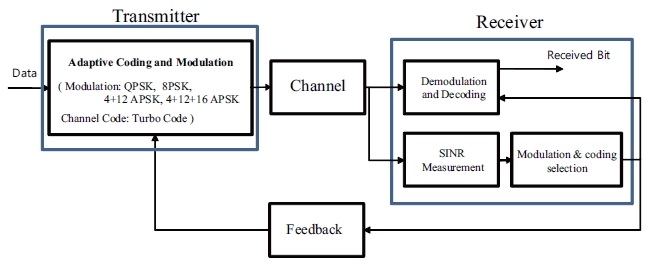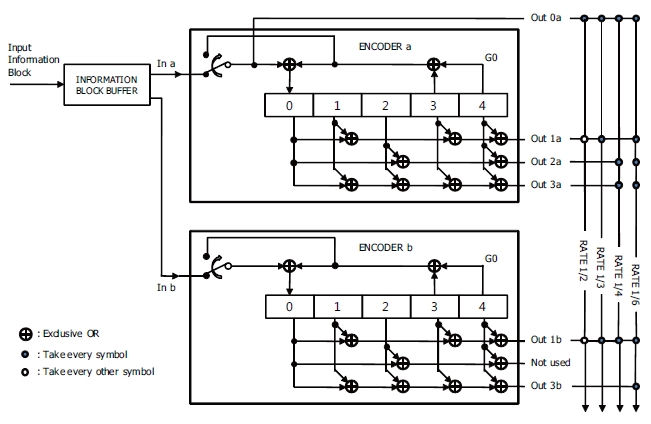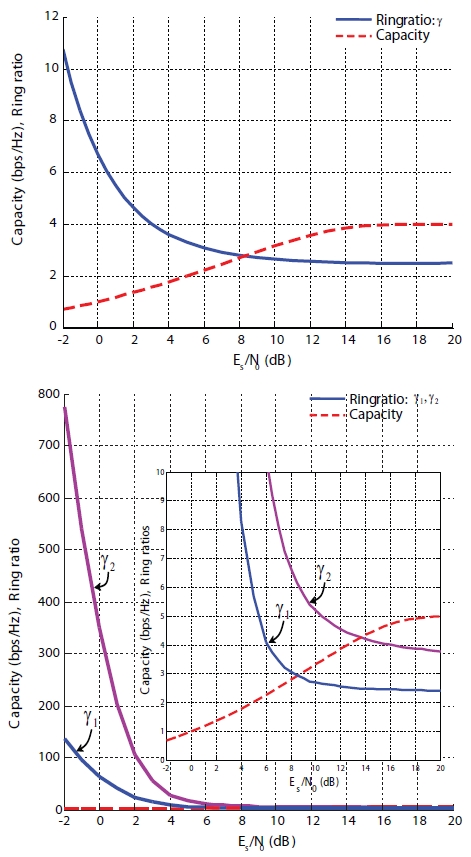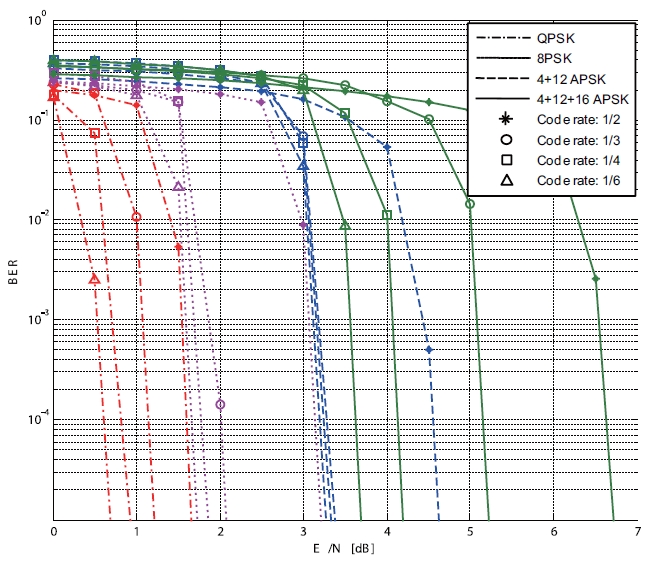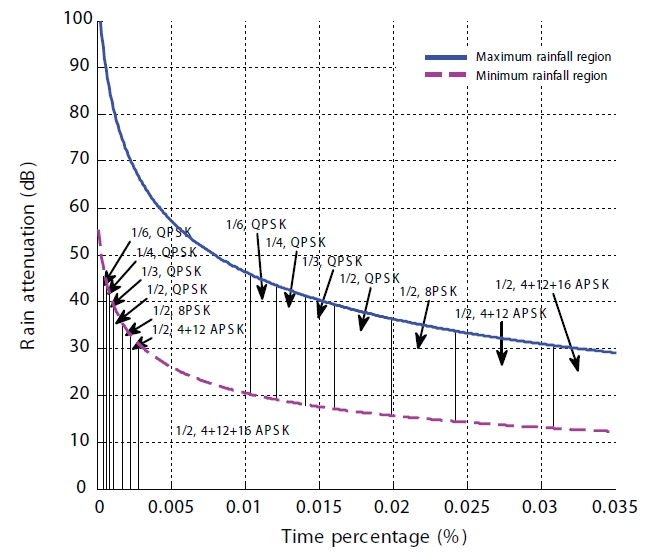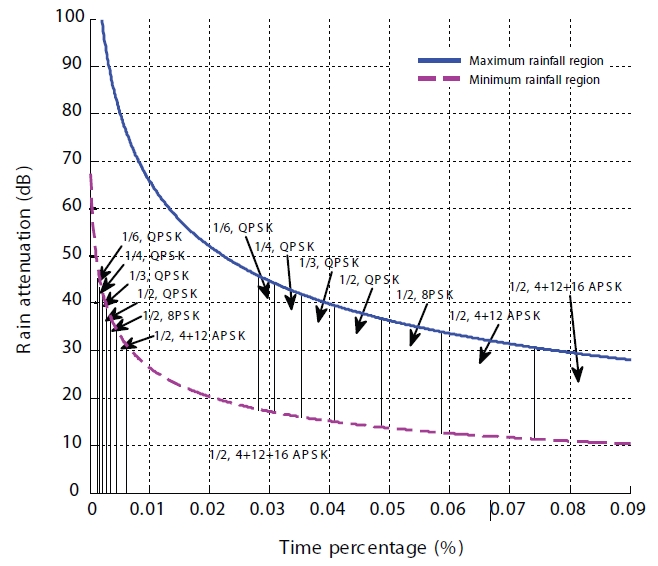



In 2007, Korea established the space development plan and showed a positive space exploration plan aiming for the development of a lunar probe until 2020 (Lee 2009). Since a disconnection in a communication link can occur in the communications for space exploration due to the locations of the transmitter and the receiver and/or the movement of heavenly bodies, large capacity data should be transmitted in a given limited time. Thus, a much higher transmission capacity than the conventional one should be secured in the given bandwidth and signal power. The technologies necessarily required for this include use of the high-order modulation with high bandwidth efficiency, application of channel coding method with the error performance near to Shannon Limit, and securing of a wider bandwidth using Ka band frequency. However, in the space communications using Ka band frequency, a rainfall can reduce the link availability by seriously affecting the communication link. To reduce the time percentage and to increase the link availability, operation with enhanced link margin is needed. It can, however, increase the power consumption by the system. Thus, an adaptive coding and modulation (ACM) scheme is required to minimize the power loss by rainfall in the space communications in Ka band. Digital video broadcasting - satellite - second generation (DVB-S2) which provides the satellite broadcasting in Ka band compensates the rain attenuation by setting the ACM levels composed of totally 28 different levels (European Telecommunications Standards Institute [ETSI] 2009).
To continuously transmit large capacity telemetry data with error-free in space communications, channel coding schemes such as turbo code and/or low density parity check (LDPC) code should be used in addition to a bandwidth efficient modulation method. It is well known that turbo code has the near-Shannon Limit error performance and the encoder of turbo code is relatively simpler than that of LDPC code. Consultative Committee for Space Data Systems (CCSDS) has recommended the turbo code as a channel code for space communications in which two convolution encoders with the constraint length of 5 and the code rates of 1/2, 1/3, 1/4 and 1/6, are parallel concatenated (CCSDS 2003). Amplitude phase shift keying (APSK) is a modulation method by which large capacity data can be transmitted without additional increase of bandwidth, and shows the similar performance to that of rectangular M-ary quadrature amplitude modulation (M-QAM) in a linear AWGN channel. In addition, APSK is an appropriate method for the satellite and space communications using a high power amplifier such as traveling wave tube amplifier (TWTA) and/or solid-state power amplifier (SSPA). Such APSK modulation method can have various types according to the M levels. 4+12 APSK and 4+12+16 APSK of the various types have been adopted as the standard modulation methods in DVB-S2 in addition to the conventional quadrature phase shift keying (QPSK) and 8PSK (ETSI 2009), and they are also considered as the modulation methods for a high data rate telemetry transmission in CCSDS Experimental Specification (CCSDS 2007).
In this paper, for the reliable telemetry transmission in the space communications in Ka band, we propose the ACM level applying the turbo code recommended by CCSDS and QPSK, 8PSK, 4+12 APSK and 4+12+16 APSK to overcome the performance loss due to rain attenuation. For this purpose, optimum ring ratios for 4+12 and 4+12+16 APSK signals are investigated for each coding rate, and the required Eb/N0 is obtained for all the modulation methods by analyzing the bit error rate (BER). Finally, we decide the ACM level through the spectral efficiency and the required
2. SYSTEM MODEL AND OPTIMUM RING RATIO
In this paper, we assumed the ACM system that can reduce the signal attenuation by rainfall in the atmospheric environment to continuously transmit large capacity telemetry data with high efficiency and high reliability. Fig. 1 shows the block diagram of the ACM system that the turbo codes with the coding rates of 1/2, 1/3, 1/4, and 1/6, and the modulation methods of QPSK, 8PSK, 4+12 APSK, and 4+12+16 APSK are applied. Fig. 2 shows the CCSDS-recommended turbo code. As shown in Fig. 1, the receiver (ground station) measures the signal to interference and noise ratio (SINR) from the received signals and selects the coding rate and the modulation order using SINR. And then, the selected system information is fed back to the transmitter (lunar probe). The transmitter, using the information received from the receiver, alters the coding rate and the modulation method adaptively to the channel conditions, and then, transmits the information data to the receiver.
To apply either 4+12 APSK or 4+12+16 APSK, which are considered in Fig. 1, the optimum constellations should first be obtained according to the coding rates of the turbo encoder. The optimum constellations of the modulation methods, 4+12 APSK and 4+12+16 APSK, for a given SNR, or equivalently, for a given spectral efficiency can be obtained by using mutual information or capacity. The mutual information is calculated using the following equation (Costello et al. 1998, De Gaudenzi et al. 2006),
where χ is a transmitted signal set, Es is an average symbol energy and n is a Gaussian distributed noise random variable with zero mean and variance of
Typically 4+12 APSK has two rings (
[Table 1.] Optimum ring ratios for 4+12 and 4+12+16 APSK.
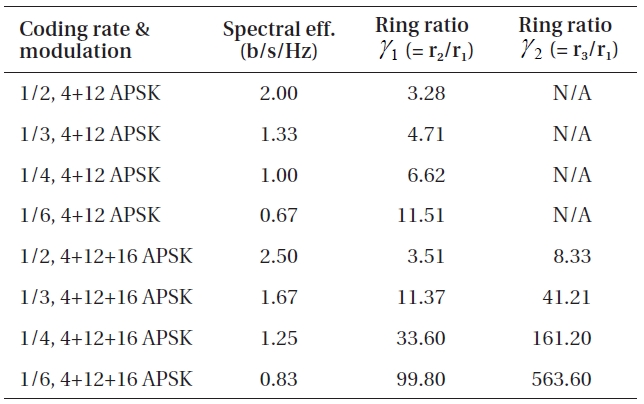
Optimum ring ratios for 4+12 and 4+12+16 APSK.
3. ACM FOR A RELIABLE TELEMETRY TRANSMISSION
Rainfall seriously decreases the link availability in Ka band space communications. To increase the link availability, we should increase the link margin over a certain value or use the hierarchical modulation. However, these methods also increase the system power consumption and are slow in responding to rainfall environmental change. One of the best solutions for this impairment is the use of ACM scheme which can minimize the power loss by rainfall. In this section, we provide the ACM level for the reliable telemetry data transmission.
Fig. 4 shows the BER curves for turbo coded QPSK, 8PSK, 4+2 APSK, and 4+12+16 APSK with the optimum ring ratios presented in Table 1. Here, the information block size is 8,920 bits, the square-root raised cosine (SRRC) filter is considered as the spectral shaping filter and the roll-off factors of the filter for each modulation method are 0.2 for QPSK and 0.35 for the others. Fig. 5 shows
As can be seen from Figs. 4 and 5, the BER performances for the 4+12 APSK code rates of 1/3, 1/4 and 1/6 are considerably close to each other. The reason for this is that the coding gain obtained is less than the expected since the minimum distance between the signal points on the inner ring (
From summarization of the coding rates and modulation methods shown in Fig. 5 based on the required
where
In Eq. (3),
Table 2 shows the link margin derived through the calculated

ACM level.
3.2 Application to domestic rain environment
The rain characteristics can be represented by the rainfall intensity which is precipitation of rainfall per unit hour (mm/hr). Time percentage is another important physical quantity represented as the percentage of time that specified rainfall intensity is exceeded (Roddy 2006). In Korea, the rainfall intensity varies depending on the regions. For example, when the time percentage is less than 0.01%, the rainfall intensity range is from the minimum 30 to the maximum 55 mm/hr, depending on the regions (Lee & Shin 1998). Figs. 6 and 7 show the rain attenuations at 32 GHz frequency in Ka band for the time percentages during one-year period and the four-month maximum rainfall season in the areas, minimum and maximum rainfall regions in Korea, based on the analysis of Lee & Shin (1998). Also, the figures show range of each ACM level on the time percentage based on the link margin shown in Table 2.
As can be seen from Figs. 6 and 7, if it is assumed that the ACM method is not applied, and the highest coding rate, 1/2, and 4+12+16 APSK are used, approximately 30.71 dB of rain attenuation can be overcome. In the case where the link margin is 30.71 dB, during the four-month maximum rainfall season, the time percentages are 0.0738% in the maximum rainfall region and 0.006385% in the minimum rainfall region, approximately, and the link availabilities are 99.9262% and 99.993615% in the maximum and minimum rainfall regions, respectively. On the other hand, when the ACM scheme applied, the time percentages can be reduced down to about 0.0286% in the maximum rainfall region and 0.001563% in the minimum rainfall region, and thus, the link availabilities can be improved up to 99.9714% and 99.998437%, respectively. Table 3 shows the time percentages in the maximum and minimum rainfall regions for the ACM levels.
From Tables 2 and 3, we see that the application of ACM scheme can improve the link availability. However, as shown in Table 2, the spectral efficiencies of level 7 and level 1 are 2.5 and 0.33, respectively. This indicates that the application of ACM scheme causes a requirement of longer communication time because, as the level of ACM is low, the effective data rate decreases. Hence, the ACM scheme can be used more efficiently when there is sufficient communication time available. In addition, Table 3 represents the time percentage analyzed over one-year period and the four-month maximum rainfall season. However, the available communication time is limited in space communications due to the location of the transmitter and the receiver and/or the movement of heavenly bodies. Thus, rather than applying the results in Table 2 directly, the ACM level analysis provided in this paper should be carried out with the time percentage depending on the available space communication time in practice. If it is assumed that the communications between a lunar probe and a ground station is possible when the moon is seen, averagely 12 hours of communications are possible in one day. Therefore, the time percentage and the link availability for the ACM level provided in this paper can be obtained by considering half of the time percentage shown in Table 3.
[Fig. 5.] Capacity for modulation methods and Eb/N0 (dB) required to satisfy the target BER of 10-5.
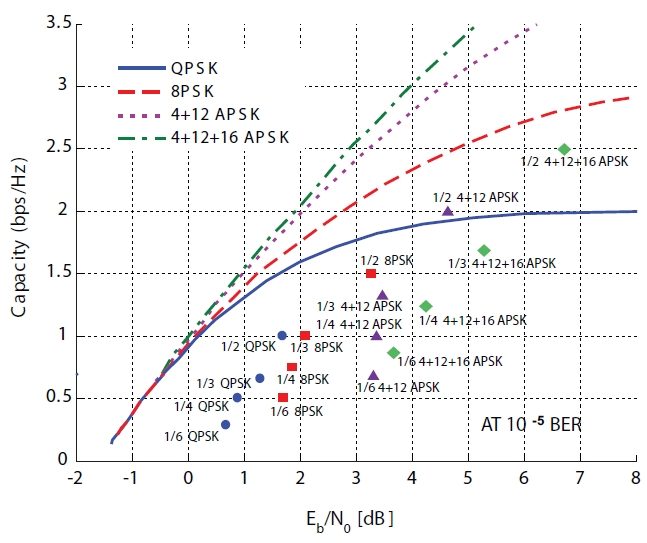
[Table 3.] Time percentage for each ACM level.

Time percentage for each ACM level.
In this paper, for the reliable telemetry transmission in the space communications in Ka band, we proposed the ACM level to overcome the rain attenuation by considering the CCSDS-recommended turbo codes with the coding rates 1/2, 1/3, 1/4 and 1/6, and QPSK, 8PSK, 4+12 APSK, and 4+12+16 APSK. In addition, applying the proposed ACM levels to the domestics rain environment, we verified that the time percentage was lowered and the link availability was improved. We expect that the ACM scheme provided here may be a useful reference for designing the space communications system for lunar exploration since it reduces the system power consumption and allows seamless high rate transmission of multimedia telemetry data in Ka band.
This research was supported by National Space Lab (NSL) program through the National Research Foundation of Korea funded by the Ministry of Education, Science and Technology (2009-0082437).

